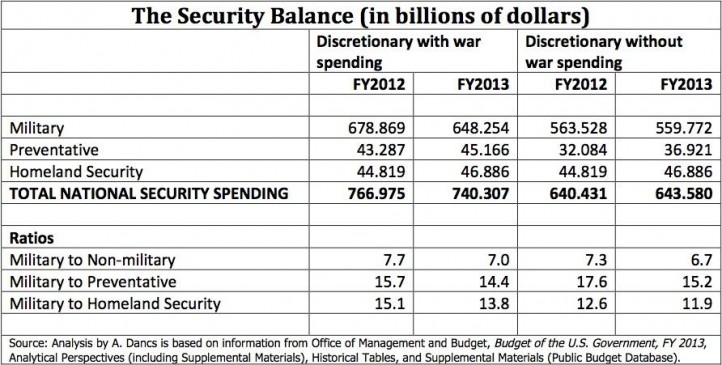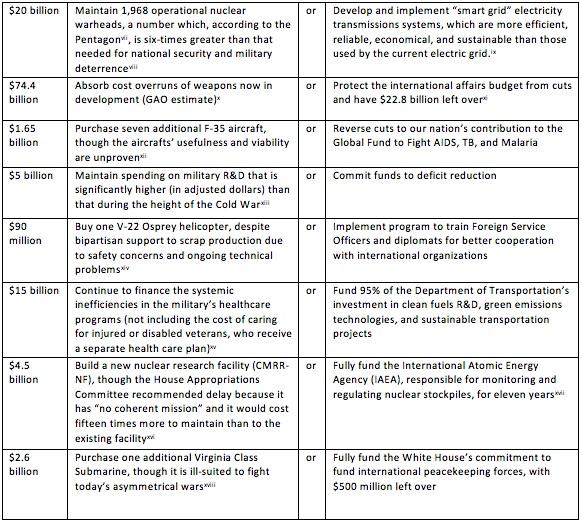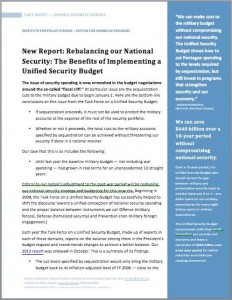CLICK HERE TO DOWNLOAD FACT SHEET AS A PDF.
“We can make cuts to the military budget without compromising our national security. The Unified Security Budget shows how to cut Pentagon spending to the levels required by sequestration, but still invest in programs that strengthen national security.”
– Miriam Pemberton, Institute for Policy Studies
The issue of security spending is now enmeshed in the budget negotiations around the so-called “fiscal cliff.” At particular issue are the sequestration cuts to the military budget due to begin January 2. Here are the bottom-line conclusions on this issue from the Task Force on a Unified Security Budget:
- If sequestration proceeds, it must not be used to protect the military accounts at the expense of the rest of the security portfolio.
- Whether or not it proceeds, the total cuts to the military accounts specified by sequestration can be achieved without threatening our security if done in a rational manner.
Our case that this is so includes the following:
- Until last year the baseline military budget — not including war spending — had grown in real terms for an unprecedented 13 straight years.[i]
Critical to our nation’s adjustment to the post-war period will be reshaping our national security strategy and budgeting for this new era. Beginning in 2004, the Task Force on a Unified Security Budget has successfully helped to shift the discourse toward a unified conception of national security spending and the proper balance between instruments we call Offense (military forces), Defense (homeland security) and Prevention (non-military foreign engagement.)
Each year the Task Force on a Unified Security Budget, made up of experts in each of these domains, reports on the balance among them in the President’s budget request and recommends changes to achieve a better balance. Our 2012 report was released in October. This is a summary of its findings.
- The cut levels specified by sequestration would only bring the military budget back to its inflation-adjusted level of FY 2006 — close to the highest level since World War II and the second-to-last year of the George W. Bush administration[ii]. Was anyone, we wonder, worried that we were disarming ourselves then?
- The military’s blank check over this period has had predictable results in the form of massive waste. The estimate of cost growth in planned procurement spending is $74.4 billion over the last year alone, according to the Government Accountability Office, the investigative arm of Congress. This would cover the entire amount of next year’s sequestration, with $20 billion left over.[iii]
Reducing spending to 2006 levels will leave our military dominant in every dimension, including air power, sea power, and ground forces deployment, as well as in transport, infrastructure, communications, and intelligence.[iv]
Short term: Some modest improvement
Long term: Improvement disappears
President Obama’s budget request for FY 2013 does achieve modest rebalancing of the security budget. For FY 2012 the request allocated $7.30 to the base military budget for every $1 devoted to the nonmilitary portions of the security budget. The FY 2013 budget narrowed this gap, allocating $6.70 for every dollar provided for nonmilitary security.

Unfortunately the ten-year plan in the President’s request would widen the gap between the budgets for military spending and prevention: from 10 to 1 in FY 2012 to 11.5 to 1 in FY 2021.
Recommendations from the Task Force
For FY 2013 our budget recommends Pentagon spending reductions of $71.8 billion and additions to the prevention budget of $29.2 billion, while realigning some spending priorities on homeland security but leaving its overall spending level essentially unchanged:

The budgetary shifts we recommend would leave a remainder of $42.7 billion for deficit reduction and other job-creating investment. Our prevention budget makes relatively small, targeted additions to address specific shortfalls in areas as nuclear nonproliferation, peacekeeping forces, and development assistance.
We also recommend that the largest addition to the prevention budget be in the area of climate security. Unless we invest seriously to stabilize the climate, the resulting increased weather extremes will be, in the U[i].S. military’s words, “threat multipliers” for instability and conflict.
In addition, these investments will pay dividends for job creation at home. The components of climate stabilization — clean energy sources connected by a smart grid, clean transportation, and energy efficiency in our buildings and industrial processes — are foundational elements of the rapidly emerging global green economy. And a shift of funding from military to climate security would result in a net increase in employment. A 2011 study by economists at the University of Massachusetts found that $1 billion spent on the military generates about 11,000 jobs as compared to the nearly 17,000 jobs generated by the same amount invested in clean energy.
Rebalancing our security: The 10-year horizon
Our Task Force plan outlines an alternative trajectory for spending on offense and prevention that would achieve the benchmark of $1 trillion in military cuts over 10 years—consistent with the recommendations of such bi-partisan commissions as the Bowles-Simpson Commission and the Rivlin-Domenici Commission.

This framework provides $123 billion for international affairs over 10 years. It would increase spending on diplomacy during this period by 28 percent over the president’s request, and increase spending on development and humanitarian assistance by 40 percent.
Overall, our plan would achieve a 20 percent increase in the international affairs budget, concentrated in the core missions of diplomacy and development. Over this 10-year period, the gap between offense and prevention spending would narrow to a better balance of eight to one.
This leaves a remainder of $440 billion over the next decade. In a late April speech at the AFL-CIO, President Obama outlined the budget shift he wanted to see as our nation transitions from its war footing: “It’s time to take some of the money that we spend on wars, use half of it to pay down our debt, and use the rest of it to do some nation-building here at home.”[i] Our 10-year budget proposal is consistent with these priorities. It would allow for $200 billion for deficit reduction and about $240 billion for “nation-building here at home.”

Unified security budgeting brings into focus trade-offs between military and preventive security, such as the tradeoffs above. Ending two wars gives us the opportunity to rebalance our security budget to shift resources toward preventive and truly defensive security tools, while investing the remainder in deficit reduction and in “nation building at home.”
[1] Lawrence Korb, “Cuts would not affect security,” New York Times, September 9, 2012. http://www.nytimes.com/roomfordebate/2012/09/09/how-big-should-the-defense-budget-be/cuts-would-not-affect-security.
[2] Ibid.
[3] GAO, “Defense Acquisitions: Assessments of Selected Weapon Programs” (March 2012), available at http://www.gao.gov/assets/590/589695.pdf.
[4] Sustainable Defense Task Force, “Debt, Deficits, and Defense: A Way Forward” (2010), available at http://www.comw.org/pda/fulltext/1006SDTFreport.pdf.
[5] Robert Pollin and Heidi Garrett-Peltier, “The U.S. Employment Effects of Military and Domestic Spending Priorities: 2011 Update” (Amherst: University of Massachusetts, 2011), available at www.peri.umass.edu/…/PERI_military_spending_2011.pdf.
[6] The White House: Office of the Press Secretary. “Remarks by the President at the Building and Construction Trades Department Conference,” April 30, 2012, available at http://www.whitehouse.gov/the-press-office/2012/04/30/remarks-president-building-and-construction-trades-department-conference.
[7] Department of Defense, “Sustaining U.S. Global Leadership,” January, 2012, p. 5, available at http://www.defense.gov/news/Defense_Strategic_Guidance.pdf.
[8] Unified Security Budget FY 2013.
[9] Unified Security Budget 2013
[10] This estimate is for the lifetime cost. Government Accountability Office, “Defense Acquisitions: Assessments of Selected Weapons Programs” (Washington: Government Accountability Office, 2012).
[11] Unified Security Budget 2013
[12] Winslow Wheeler, “The Jet That Ate the Pentagon,” Foreign Policy, (April 26, 2012), available at: http://www.foreignpolicy.com/articles/2012/04/26/the_jet_that_ate_the_pentagon?print=yes&hidecomments=yes&page=full.
[13] Department of Defense, “Overview—United States Department of Defense Fiscal Year 2013 Budget Request.”
[14] Department of the Navy, “Department of the Navy Fiscal Year 2013 Budget Estimates,” available at http://www.finance.hq.navy.mil/FMB/13pres/SCN_BOOK.pdf.
[15] Unified Security Budget, FY 2013
[16] “November 2010 Update to the National Defense Authorization Act of FY 2010: Section 1251 Report,” available at: http://www.lasg.org/CMRR/Sect1251_update_17Nov2010.pdf.
[17] “IAEA Regular Budget,” available at: http://www.iaea.org/About/budget.html
[18] “Department of the Navy Fiscal Year 2013 Budget Estimates,” p. 3-1, available at http://www.finance.hq.navy.mil/FMB/13pres/SCN_BOOK.pdf.

